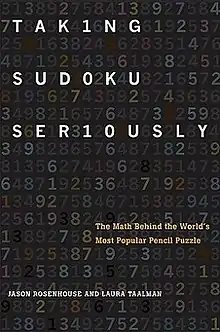Taking Sudoku Seriously
Taking Sudoku Seriously: The math behind the world's most popular pencil puzzle is a book on the mathematics of Sudoku. It was written by Jason Rosenhouse and Laura Taalman, and published in 2011 by the Oxford University Press. The Basic Library List Committee of the Mathematical Association of America has suggested its inclusion in undergraduate mathematics libraries.[1] It was the 2012 winner of the PROSE Awards in the popular science and popular mathematics category.[2]
 | |
| Author |
|
|---|---|
| Subject | Mathematics–Social aspects, Sudoku |
| Publisher | Oxford University Press |
Publication date | 2011 |
| Pages | 214 |
| Awards | PROSE: Popular science & Popular mathematics |
| ISBN | 978-0-19-991315-2 |
| OCLC | 774293834 |
| 793.74 | |
| LC Class | GV1507.S83 |
Topics
The book is centered around Sudoku puzzles, using them as a jumping-off point "to discuss a broad spectrum of topics in mathematics".[1] In many cases these topics are presented through simplified examples which can be understood by hand calculation before extending them to Sudoku itself using computers.[3] The book also includes discussions on the nature of mathematics and the use of computers in mathematics.[4]
After an introductory chapter on Sudoku and its deductive puzzle-solving techniques[1] (also touching on Euler tours and Hamiltonian cycles),[5] the book has eight more chapters and an epilogue. Chapters two and three discuss Latin squares, the thirty-six officers problem, Leonhard Euler's incorrect conjecture on Graeco-Latin squares, and related topics.[1][4] Here, a Latin square is a grid of numbers with the same property as a Sudoku puzzle's solution of having each number appear once in each row and once in each column. They can be traced back to mathematics in medieval Islam, were studied recreationally by Benjamin Franklin, and have seen more serious application in the design of experiments and in error correction codes.[6] Sudoku puzzles also constrain square blocks of cells to contain each number once, making a restricted type of Latin square called a gerechte design.[1]
Chapters four and five concern the combinatorial enumeration of completed Sudoku puzzles, before and after factoring out the symmetries and equivalence classes of these puzzles using Burnside's lemma in group theory. Chapter six looks at combinatorial search techniques for finding small systems of givens that uniquely define a puzzle solution; soon after the book's publication, these methods were used to show that the minimum possible number of givens is 17.[1][4][5]
The next two chapters look at two different mathematical formalizations of the problem of going from a Sudoku problem to its solution, one involving graph coloring (more precisely, precoloring extension of the Sudoku graph) and another involving using the Gröbner basis method to solve systems of polynomial equations. The final chapter studies questions in extremal combinatorics motivated by Sudoku, and (although 76 Sudoku puzzles of various types are scattered throughout the earlier chapters) the epilogue presents a collection of 20 additional puzzles, in advanced variations of Sudoku.[1][4]
Audience and reception
This book is intended for a general audience interested in recreational mathematics,[7] including mathematically inclined high school students.[4] It is intended to counter the widespread misimpression that Sudoku is not mathematical,[5][6][8] and could help students appreciate the distinction between mathematical reasoning and rote calculation.[4][5][7] Reviewer Mark Hunacek writes that "a person with very limited background in mathematics, or a person without much experience solving Sudoku puzzles, could still find something of interest here".[1] It can also be used by professional mathematicians, for instance in setting research projects for students.[7] It is unlikely to improve Sudoku puzzle-solving skills, but Keith Devlin writes that Sudoku players can still gain "a deeper appreciation for the puzzle they love".[6] However, reviewer Nicola Tilt is unsure of the book's audience, writing that "the content may be deemed a little simplistic for mathematicians, and a little too diverse for real puzzle enthusiasts".[8]
Reviewer David Bevan calls the book "beautifully produced", "well written", and "highly recommended".[4] Reviewer Mark Hunacek calls it "a delightful book which I thoroughly enjoyed reading".[1] And (despite complaining that the section on graph coloring is "abstract and demanding" and overly US-centric in its approach), reviewer Donald Keedwell writes "This well-written book would be of interest to anyone, mathematician or not, who likes solving Sudoku puzzles."[5]
References
- Hunacek, Mark (January 2012), "Review of Taking Sudoku Seriously", MAA Reviews, Mathematical Association of America
- "2012 Award Winners", PROSE Awards, Association of American Publishers, retrieved 2018-05-14
- Hösli, Hansueli, "Review of Taking Sudoku Seriously", zbMATH, Zbl 1239.00014
- Bevan, David (November 2013), "Review of Taking Sudoku Seriously", The Mathematical Gazette, 97 (540): 574–575, doi:10.1017/S0025557200000589, JSTOR 24496749
- Keedwell, Donald (February 2018), "Review of Taking Sudoku Seriously", The Mathematical Gazette, 102 (553): 186–187, doi:10.1017/mag.2018.39
- Devlin, Keith (January 28, 2012), "The numbers game (review of Taking Sudoku Seriously)", The Wall Street Journal
- Li, Aihua, "Review of Taking Sudoku Seriously", Mathematical Reviews, MR 2859240
- Tilt, Nicola (February 2013), "Review of Taking Sudoku Seriously", Significance, Royal Statistical Society, 10 (1): 43, doi:10.1111/j.1740-9713.2013.00640.x